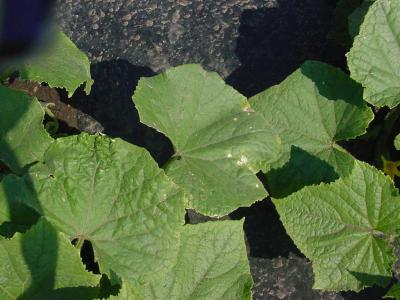
Cucumbers require fertile, well-drained soils, and full sun. Test the soil, and apply, and incorporate recommended amounts of fertilizer. If a soil test has not been done, incorporate 1-2 pounds of garden fertilizers such as 10-10-10 per 100 square feet before planting.
Cucumbers for transplanting can be started indoors 2-3 weeks before planting outdoors. Peat pots, jiffy pellets, or flats with cells can be used. When using flats or peat pots, fill them with soilless potting mix. Sow more seeds per container or cell then thin to the desired number after germination. Harden the seedlings outdoors in a protected location to reduce plant stress before transplanting.
Cucumbers and other vine crops are monoecious plants which have separate male and female flowers on the same plant. The male flowers appear first and female flowers shortly later. The female flowers have small immature fruit at the base of the flower and male flower do not have any. Pollen is transferred from male to female flower by bees or other insects. When pollinated properly, female flower develops into fruit. There are different types of cucumber hybrids such as gynoecious varieties that produce predominantly female flowers, and seeds of monoecious varieties are mixed with it for pollination. They are very productive when pollenizer is present. There are also cucumber hybrids that produce fruits without pollination called parthenocarpic varieties resulting into fruits that contain no seeds. Such varieties need to be isolated from standard varieties to prevent cross-pollination and development of fruits with seeds inside. Cucumbers cucumber varieties can cross pollinate with one another but not with squash, pumpkins, muskmelons, or watermelons.
Cucumbers can be grown on bare ground or in black plastic mulch. When planted on bare ground, control weeds with frequent, shallow cultivation, and hand pulling until the vines cover the ground. When grown plastic mulch, weeds need to be controlled between plastic mulch strips. Irrigate once a week and the amount of water applied depends on amount of rainfall in a week. Control cucumber beetles as soon as they are observed on the plants by using floating row cover, or by using insecticides. When floating row cover is used, remove it when flowering begin.Slicing – Thunder – Very early; Dasher II – very productive, midseason; Fanfare – Semi-bush, monoecious; Marketmore 76 – uniform, dark green fruit
Pickling – County Fair – seedless if isolated from other cucumbers; Calypso – gynoecious, early maturing; Farncipak M – gynoecious, early season.
Burpless – Diva – gynoecious, parthenocarpic; Sweet Slice – monoecious slicing; Tasty Green – Monoecious, slicing
Bush – Salad Bush – slicing; Spacemaster – slicing; Bush Pickle – pickling.
Heirloom – Lemon – light yellow skin, white flesh, round and similar in size to lemon; White Wonder – cylindrical fruits with ivory-white skin.
Bacterial Disease
Environmental Damage
Fungal Disease
Insect Damage
Additional pests and problems that may affect this plant:
Diseases:
Bitterness of fruit occurs when plant is stressed by hot, dry weather. Plant bitter free varieties such as Sweet Slice. Misshapen fruits occur due to poor pollination. Spray when bees are out of the field either late in the evening or early in the morning.